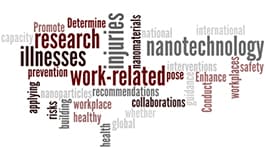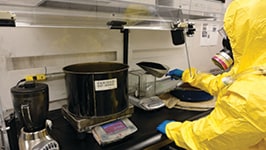Nanotechnology
How to Reduce Exposures When 3D Printing with Plastic Filament
Technical Report: Occupational Exposure Sampling for Engineered Nanomaterials
Current Intelligence Bulletin 70: Health Effects of Occupational Exposure to Silver Nanomaterials
3D Printing with Filaments: Health and Safety Questions to Ask
3D Printing with Metal Powders: Health and Safety Questions to Ask

What is nanotechnology?
Nanotechnology is the manipulation of matter on a near-atomic scale to produce new structures, materials and devices. The technology promises scientific advancement in many sectors such as medicine, consumer products, energy, materials, and manufacturing. Nanotechnology refers to engineered structures, devices, and systems. Nanomaterials have a length scale between 1 and 100 nanometers. At this size, materials begin to exhibit unique properties that affect physical, chemical, and biological behavior. Researching, developing, and utilizing these properties is at the heart of new technology.
What are the risks to workers?
Workers within nanotechnology-related industries may be exposed to uniquely engineered materials. This includes materials with new sizes, shapes, and physical and chemical properties. Occupational health risks associated with manufacturing and using nanomaterials are not yet clearly understood. More research is needed to understand the impact of nanotechnology on health, and to determine appropriate exposure monitoring and control strategies. At this time, the limited evidence available suggests caution when potential exposures to free–unbound nanoparticles may occur.
What is Known?
Studies have indicated that low solubility nanoparticles are more toxic than larger particles on a mass for mass basis. Particle surface area and surface chemistry are strong indicators for observed responses in cell cultures and animals. Studies suggests that some nanoparticles can move from the respiratory system to other organs. Research is continuing to understand how these unique properties may lead to specific health effects.
The NIOSH Effort: The Nanotechnology Research Center
NIOSH, through its Nanotechnology Research Center (NTRC), conducts research and provides guidance on the occupational safety and health implications and applications of advanced materials and nanotechnology. The Center is supported by a diverse group of scientists from across NIOSH.
The NTRC focuses on:
- Increasing the understanding of hazards and health risks to nanomaterial workers.
- Preventing occupational exposures to advanced materials such as nanomaterials through a better understanding of control and protective technologies.
NTRC activities include:
- Creating and implementing a strategic plan for investigating critical issues.
- Coordinating the NIOSH research effort.
- Developing research partnerships.
- Disseminating information and guidance.




